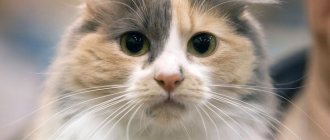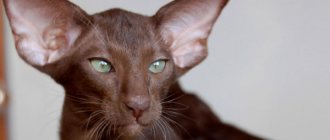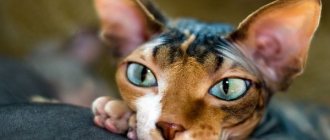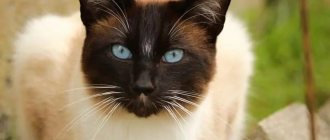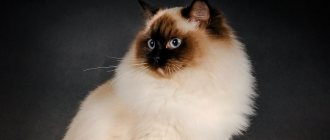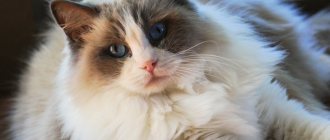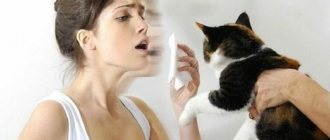A breed with downturned ears
- Fact 1:
In English it is called Scottish Fold - Fact 2:
Ears that curl forward and down are the result of a gene mutation - Fact 3:
Cats live up to 15 years, and sometimes up to 18! - Fact 4:
Cats of this breed can sit like a person, with their lower legs extended in a funny way.
The Scottish Fold is a cat breed native to Scotland that has funny ears that curl downwards due to a mutation.
In the short period of its existence, the breed of Scottish Fold cats (another name is Scottish Fold) has gained incredible popularity among professional breeders and ordinary amateurs. The reason for this mainly lies in the unusual appearance of fold-eared cats: pressed (folded) ears make the face of representatives of this breed very cute, emphasizing their expressive eyes.
The Scottish Fold breed originates from an ordinary domestic cat, which was born on the farm of a Scotsman in the 60s of the last century.
| That cat had a congenital mutation in the form of deformed ears pressed to the head, which the owner of the animal then tried to fix through inbreeding. |
Unfortunately, the resulting offspring exhibited multiple developmental anomalies, and further selection of the breed was suspended.
But thanks to the initiative of breeders from the USA, who began to cross Scottish Fold cats with American and British shorthair cats, the Scottish Fold genes, which are dangerous to health, were defeated. At the same time, the breed acquired some recognizable features that still partly make it similar to the “donor” breeds - these are the body structure features and plush fur characteristic of the “British” and “Americans”.
Appearance of the Scottish Fold and photo
Scottish Folds are medium-sized cats of harmonious build, with strong but graceful bones. The weight of adult cats varies in the range of 4-6 kg, cats - 2.7-4 kg. The legs are straight and muscular, the tail is medium-sized or long, the tip is rounded. A fluffy tail may be a reason for disqualification at a show.
The head is rounded, the chin and jaws are strong and well developed. The nose is short and wide, the eyes are large, wide open, round. The ears are small: the pinnae are pressed to the head and cover the auditory openings, the tips of the ears are directed downwards.
The coat is very soft (reminiscent of plush), short, thick, the guard hair and undercoat form a homogeneous mass. The color can be any: solid or multi-colored, striped, spotted, marbled, bicolor, tabby, color point. The shades of wool are also as varied as possible - blue, lilac, gray, smoky, sand, chocolate, white, black, cream, mixed options. Any eye color, but linked to the coat color, can be yellow, emerald, blue, amber.
Choosing the right kitten
The most characteristic feature of the American Curl is the curl on the ears .
This is exactly why you need to choose a kitten. The best time for this is when the curl is visible clearly and clearly - and this is 4 months from birth. It is after this time that the wrapping of the ears ends. It will be immediately noticeable whether it will be a breeding cat, whether your pet is applying for an exhibition or whether it will be a domestic cat: • a domestic cat will have the smallest angle of wrapping (the first degree); • a larger angle or a different degree will show you a breeding cat, it is better to keep this one for breeding; • a steep curl or third degree is a manifestation of an exhibition handsome man.
The price of the kitten will depend on this. Ideally, a kitten's ear curl should be in the form of a neat curve, similar to a crescent. It is worth noting that in advance, before the end of the 4-month period, it is almost impossible to determine to what degree the ear will twist. You don’t even have to take the kitten’s relatives; two show kittens can give birth to both a show kitten and a domestic one.
In addition to appearance, you need to pay attention to the pedigree of the little Curl. The price will also depend on who its parents were: • if the kitten does not have a pedigree, then its price will be in the range of 3-10 thousand rubles; • breeding curls are already valued more - from 10 to 20 thousand; • purebred show kittens will cost the buyer 25,000 or more.
When purchasing, you should read in detail all the documents for the kitten, and especially look at its behavior. They should be calm and not at all shy.
Where do fold ears come from?
The Scottish Fold breed has this peculiarity: if the kittens' ears remain straight as they grow older, the animals are called Scottish Straight. In general, straight-eared kittens are common, since in order to get good healthy offspring, responsible breeders do not use two fold-eared animals - one of the pair must be straight-eared. When two fold-eared animals mate, weak kittens with developmental pathologies are often born.
The initial cost of a Scottish Fold kitten is 3,000 rubles. The price depends on the presence (or absence) of a pedigree, the titles of the kitten’s parents, and the rarity of the color. If you want to buy a kitten with floppy ears, it is better to get an animal at the age of 3 months. Although the characteristic fold of the ear is formed in the baby on the 18th day of life, only at the age of 3 months it becomes finally clear whether his ears will be pressed or erect.
Ukrainian Levkoy
These hairless cats, with forward-curved ears, were bred in 2004 thanks to the efforts of Kyiv felinologist Elena Biryukova. To obtain a new breed, the woman used Don Sphynxes and Scottish Folds. As a result of the experiments, unusual, almost hairless kittens with huge eyes and curled ears were born. The new breed was called the “Ukrainian Levkoy” and quickly gained popularity among residents of many countries.
Ukrainian Levkoys are medium-sized hairless cats with well-developed muscles and a stepped profile. A distinctive feature of the breed are small deformed ears with curved tips with one or two horizontal folds and a thin mouse tail.
Ukrainian Levkoys are affectionate and gentle animals with a good-natured and peaceful disposition. Curious and highly intelligent, cats with folded ears are easy to train and try to participate in all household activities.
Unusual habits, character and intelligence
Scottish Folds are balanced, moderately playful, and sometimes quite phlegmatic cats that know how to compromise and get along well with all household members (including small children) and pets. They never respond to provocations and aggression, trying to simply avoid conflict if it is brewing.
Scottish Folds are very gentle and affectionate with their owners. They love to be petted, willingly make contact without being intrusive, they know how to understand a person’s mood and show tact. These cats are, in a sense, very intelligent and do not create any particular difficulties in their maintenance: they quickly understand the purpose of the litter box and scratching post, are not picky about food, and can easily tolerate trips and preventive visits to the veterinary clinic.
The unusual appearance of these cats is complemented by funny habits. Scottish Folds can sit with their paws outstretched (like a person sits with their legs outstretched), are able to sleep on their back and can easily stand on their hind legs, stretched out in a column, like meerkats. Owners also note the quick wit and high intelligence of fold-eared cats - pets are easy to train, understand commands and sometimes even watch TV with interest. The voice of fold-eared cats is also unusual, creaky. Meowing resembles grunting.
Application
The American Curl breed is simply created for communication.
This pet will become the best companion, and its canine devotion will only contribute to the fruitful development of relationships.
Moreover, such a cat will show friendliness not only to all family members - he behaves absolutely calmly even in the presence of strangers.
The Curl always treats its owner with special reverence and under any circumstances.
At the same time, he subtly senses the situation and tries to be unobtrusive.
Cats of this breed will be happy to take an active part in all household events and activities.
On a quiet evening, they will watch TV with you and will not remain on the sidelines during general cleaning.
The Curl has a calm character, and therefore he gets along well in families with children.
The cat's natural energy, observation and endless desire to learn something new make the American Curl an almost ideal pet.
Moreover, he is able to find a common language not only with people - this cat will even make friends with a dog, and if it turns out to be a mischievous beagle or an energetic dachshund , then the newly made friends will be happy to play together in the backyard.
And this is another advantage of this breed, because when you are not at home, the Curl will not get bored.
If there are no other pets in your house, then do not forget to leave the cat a few toys and put your photo in a visible place - this will allow your pet to while away a few hours alone.
Maintenance and care
Scottish Fold cats do not require special care. Their short hair does not tangle and hardly sheds, which does not create additional hassle in keeping the house clean. But you still need to comb these cats, and for this you will need a soft slicker brush with rounded needles so as not to scratch the cat’s skin. Scottish Folds love to be brushed, including against the grain. It is enough to comb the animal once a week, and during molting - once every 2-3 days.
As mentioned above, a cat does not damage furniture and walls by scratching if it has a scratching post. If the animal does not grind its claws well enough on the scratching post, they need to be carefully trimmed by 1-2 mm every 2 weeks with special scissors for cat claws (human scissors are not suitable, they only soften the claw).
It is not necessary to wash fold-eared cats more than once every six months, unless the animal suddenly gets thoroughly dirty in something difficult to clean. Even if the owner wants to wash the Scottish Fold more often, it is not recommended to do this more than once every two months, so as not to cause irritation on the cat’s sensitive skin.
Due to the shape of the auricle, the inside of the ears of the Scottish Fold is not as well ventilated as that of ordinary cats, but, as a rule, there are no problems with the ears of this breed. You need to inspect and clean your cat's ears with a cotton swab once a week. For wiping, you can use special hygienic lotions for animal ears. If you find that the inside of your cat’s ear is wet or there is dark discharge, this should alert you and be a reason to visit a veterinarian.
Periodically (sometimes daily) it is necessary to wipe the animal’s eyes from accumulated secretions. A soft, clean cloth soaked in boiled water is suitable for this. You need to examine and brush your teeth 2 times a week.
Among personal belongings, the cat should also have a place to sleep and rest. It is better if it is a play complex with a closed house, an upper open bed or hammock, shelves and posts for climbing and sharpening claws.
Cats with a flat face: breeds and their characteristics
Cats with a flat face were artificially bred and separated into separate breeds, of which there are not many in the world. Persians are the most popular among them, although other representatives cannot be ignored, from exotic and Himalayan cats bred from Persians with their long hair to proud British or fold-eared Scottish Folds. And each of them has a characteristic feature - the brachycephalic shape of the muzzle, giving the pet a doll-like expression. But it is worth noting that such animals require special care.
Cat food
They are not picky eaters, but it is necessary to follow strict rules in feeding these cats. If you decide to train an animal to eat ready-made dry and wet food, then you need to choose nutritious, but too fatty options from the super premium class. Poultry, rabbit, lamb and fish feeds are suitable.
Since Scottish Folds are not particularly active, it is better to choose food for them labeled “for domestic cats” or “cats with a sedentary lifestyle.” The exception is kittens and young energetic cats, who need to choose foods high in protein and protein.
If the owner wants to feed the fold cat natural food, then beef, rabbit, lean poultry, offal, fermented milk products, boiled egg and boiled sea fish (small pieces 1-2 times a week) are suitable. And as an additive to meat, you need to feed the cat a little boiled rice or buckwheat, give fresh and stewed vegetables, grass (for example, parsed oats).
From time to time you need to give your cat large pieces of meat so that she has to open her mouth wider while chewing. The Scottish Fold has large jaws, which must receive a good load, otherwise the animal may develop problems with its teeth. An adult cat needs to be fed 3-4 times a day, a kitten more often - up to 6-8 times, depending on age.
History of the origin of the American Curl breed
The American Curl is a relatively new cat species whose rise to the top of popularity has had no obstacles along the way.
On a warm summer evening, two small fluffy balls with curled ears nailed to the door of a couple named Ruga, who lived in sunny California. Kind-hearted Grace Ruga was unable to drive the kittens away and took them into her home.
A black cat with curved ears was named Shulamith, and her black and white sister with an equally amazing detail in her appearance was “christened” Panda. The panda lived in the house of hospitable Americans for only a couple of weeks, after which he died in an accident.
Fate was more favorable to Shulamith - the cat lived a long and happy life. Some time after finding a home, Shulamith gave birth to kittens, several of them inherited a gene from their mother's side that makes their ears curl back in a flirtatious manner.
A kitten named Mercedes went to live with his sister Grace, and as time passed, his litter included unusual kittens. American Curls were officially recognized in 1987.
Scottish Fold health
Scottish Fold cats have a breed tendency to diseases of the musculoskeletal system. The gene that provokes pathological changes in the skeletal system is linked to the lop ear gene. Cats with short thick tails and inflexible paws are most prone to musculoskeletal disorders. It is necessary to monitor the health of such pets more closely, regularly visit the veterinary clinic with them and strictly adhere to the diet prescribed by the veterinarian.
But in general, the Scottish Fold is in good health, especially if the breeders from whom the kitten was purchased followed all the nuances of selecting a pair to produce offspring. The average lifespan of Scottish Folds is 12-15 years, but among the representatives of this breed there are many long-livers who have surpassed the 18 year mark.
To protect a cat from viral and infectious diseases, standard vaccination, periodic deworming and protection from external parasites - insectoacaricidal drops, collars, sprays - are required.
Causes of irregularly shaped ears in cats
The cause of abnormal ear structure is a mutation gene, and it is different for each breed. For example:
- Scottish Fold gene is a dominant lop ear gene with partial penetrance. Representatives of pets with this mutation have ears that “look” forward. Moreover, the degree of fit of the ears varies. The gene for fold-eared breeds is also associated with limb defects: in parallel with “wrong” ears, changes occur in the cat’s skeleton. Because of this, breeders stopped crossing two individuals of Scottish Folds with each other, thereby eliminating animal health problems.
- American Curl gene. With this mutation, the cat’s ear begins to “curl” towards the upper tip. The ear can be turned up to 180 degrees. This gene does not have a negative effect on the development of the cat and its health.
- Round ears. As a result of the predominance of the mutating gene, the animal has not the traditional triangular shape of the ears, but a round one. This “defect” was first discovered in pets in Italy, and later in America.
Health and disease of the breed
When breeding the breed, breeders sought to produce a cat with good health. And we can say that they succeeded. Sphinx elves are considered a young breed and it is too early to draw conclusions, but so far no inherited diseases have been discovered.
The breed is characterized by the problems of all hairless cats. You should protect your pet from hypothermia: colds are difficult for them. Direct sunlight is also dangerous, as it can cause burns.
If there is a hormonal imbalance, poor nutrition or poor hygiene, elves may develop skin problems. This manifests itself in the form of acne or a rash of pimples on certain parts of the body. During puberty, the entire body may become covered with small pimples. Seasonal dermatitis also occurs, most often in females during estrus. If the cat begins to scratch its skin and wounds appear, then measures must be taken to prevent infection. Contact your veterinarian: he will be able to prescribe an anti-itch medication and tell you what to do next.
If you notice that there is more skin discharge or that it has become dark brown in color, this indicates a nutritional problem. Contact a specialist to select a balanced feed.
The history of the elf cat
The Elf cat breed was created quite recently thanks to the work of breeders. The species was bred by a breeder from America, Kristen Lead, whose Canadian Sphynx died and she could not come to terms with the death of her pet. Due to the fact that Sphynx cats are predisposed to many hereditary diseases, the woman decided to breed a cat that looked similar in appearance and was in better health.
Kristen was helped in her work by her partner Karen Nelson. The first attempts to cross the Canadian Sphynx and the American Curl were not successful. Thanks to great desire and long work, elf kittens finally appeared in 2006. Outwardly, they resembled mythical creatures, which is where the name came from.
Since 2007, the Elf breed has been registered by TICA as an “experimental” breed and remains in that status to this day. International organizations still do not recognize the elf cat as a separate breed, since all the features of the species have not yet been studied.
There is a growing demand for cats among amateurs and professionals. In the CIS countries there are very few organizations for breeding this breed. For purebred elf kittens, people are sometimes forced to turn to American nurseries.
How they appeared and what they are
Some scientists argue that Persian cats have existed since the founding of Persia. Although references to charming cats with luxurious fur date back to the 17th century.
They first spread to the court of the French king thanks to Cardinal de Richelieu. It was he who introduced the fashion for such exotic animals at that time.
The emergence of the Persian Longhair dates back to 1887. Then they were divided into several subspecies, which served as an incentive for the creation of clubs for cat lovers. And at the beginning of the 20th century they became the first breed officially recognized by the English Felinological Association.
In the 20s, a subtype of the Persian appeared - extreme, and in the 50s, by crossing it with a Siamese, the Himalayan cat was created. In the 60s, a Persian cat gave birth to kittens from an American Shorthair, which were later called Exotic Shorthairs. In the Soviet Union, they first learned about such pets in 1980, and their breeding began in 1991.
